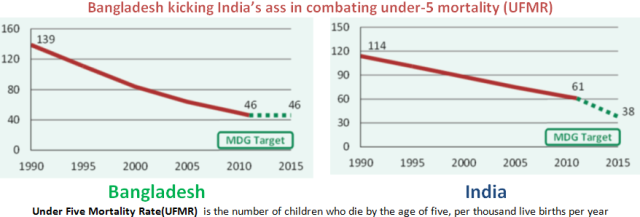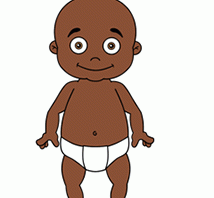
The reputation of Bangladesh is not the strongest in India. Despite our own issues, most Indians associate Bangladesh with various negative images ranging from extreme poverty and a never ending stream of refugees to a test cricket team that is a joke.
There is no question that by most economic parameters, India has outshone Bangladesh with ease. For instance, in terms of GDP per capita (market value of all officially recognized goods and services produced within each country per person) India has left Bangladesh far behind even though both countries were in similar situations in the 1980s.

Despite this massive economic advantage, India has been unable to better Bangladesh at controlling child mortality. Trends for child mortality are in complete contrast to those for economic growth.

In 2000, the United Nations Millennium Declaration formed a global partnership to reduce extreme poverty and set out a series of time-bound targets — with a deadline of 2015 — that have become known as the Millennium Development Goals (MDGs). One of these MDGs was to reduce the mortality of children under the age of five, by two-thirds. In 1990, Bangladesh had a UFMR greater than that of India. In 2010, Bangladesh achieved its MDG target. It is likely that India will be unable to achieve its UFMR target by 2015.
It is well known that India’s economic growth has not been uniform across all strata of society. Therefore economic growth has not necessarily meant an improvement in life for the entire population. In terms of healthcare, the sufferers have been the masses who do not have medical insurance and cannot afford private healthcare.
One commonly cited reason for the success of Bangladesh in combating child mortality is gender equality. The large number of women health workers and school teachers has given a significant boost to human development. India has made efforts to increase gender equality but it seems that the country’s efforts have not matched those of Bangladesh.

In 1980, for every 100 men (over the age of 25) in India, who had received senior secondary education, there were about 31 women who had achieved the same level of education. The corresponding number for Bangladesh in 1980 was 21 women for every 100 men. As per latest figures available, India has improved its ratio to 0.528. In contrast, Bangladesh has made phenomenal strides. The same ratio for Bangladesh stands at 0.784. The benefits of educating women has naturally meant a marked improvement in awareness of newborn care across the country along with an increasing female workforce that is able to successfully work towards human development.
India is supposed to be the powerhouse of the subcontinent. But true development is not reflected through the stock exchange and GDP measures. The fact of the matter is that despite our economic advances, a Baby born in Bangladesh is more likely to survive than one born in India.
————————————————————————-
Sources: http://data.worldbank.org/indicator/NY.GDP.PCAP.CD http://hdr.undp.org http://www.countdown2015mnch.org/ http://www.unicef.org/infobycountry/bangladesh_66012.html http://www.thehindu.com/news/national/bangladesh-ahead-of-india-in-gender-equality-amartya-sen/article4277151.ece http://articles.timesofindia.indiatimes.com/2013-03-05/india/37468395_1_top-killer-biggest-killers-lower-respiratory-diseases Copyright secured by Digiprove
Copyright secured by Digiprove



IF THERE IS A WILL THERE IS A WAY. IN INDIA WE GOT ONLY PREACHING LEADERS BUT PREACHING AND PRACTICING IS DIFFERENT. INDIA GOT EVERYTHING BUT THE WILL IS LACKING. HOPE A SELFLESS AND SINCERE LEADER WILL EMERGE.
This is an interesting piece of information. But don’t you think that the size of Indian population makes it difficult to achieve these MDG target?
True. But we do have a lot more resources at our disposal than Bangladesh. Maybe our priorities are slightly warped.
I think the priorities are all right….the people who hold the key to these resources are all wrong. One cannot protect a tree infested by termites by making a iron wall around it 🙂
Across the world, 22% of children under the age of 5 who die are Indian. Yet our total expenditure on healthcare is about 4% of the GDP. More than 70% of this is private expenditure. So maybe we could actually earmark more resources towards healthcare as well.
Please let me know if you’re looking for a writer for your blog.
You have some really good posts and I feel I would be a
good asset. If you ever want to take some of the load off, I’d love to write some
articles for your blog in exchange for a link back to mine.
Please send me an email if interested. Regards! http://asersa.com.ec/?option=com_k2&view=itemlist&task=user&id=339877